The keto diet is so different from other weight loss diet plans that it tends to spark concern, particularly regarding women’s health. Ther...
The keto diet is so different from other weight loss diet plans that it tends to spark concern, particularly regarding women’s health.
There is no doubt that carb restriction can promote substantial amounts of fat loss for many women, but its impact on hormone levels, fertility, pregnancy, and menopause is often misunderstood.
This naturally begs the question: Do keto weight loss results come at a cost, or is the diet a win-win for women’s health? To help answer this critical question, we’ve developed this comprehensive keto guide for women.
Here is a quick overview of the topics covered below:
- What is the keto diet, and how does it work?
- Is it healthy, safe, and effective for all women?
- Before & after keto results and success stories
- Important women’s health considerations throughout life
- Menopause & fat loss: keto for women in their 40s, 50s, and beyond
- Keto diet plans and macros for women
- Top 10 tips for long-lasting keto results
- How to find out if the keto lifestyle is right for you
- A closer look at keto for PCOS, PMS, Hot flashes, and UTIs
- Mythbusting: Dispelling false claims about keto and women’s health
- Key takeaways: Success principles and resources for women
What is the Keto Diet? A Brief Overview of How It Works
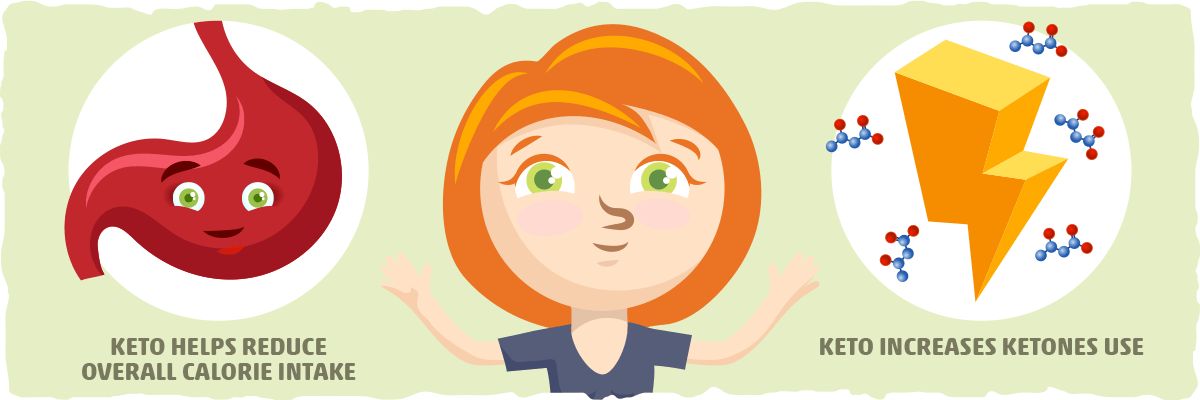
The keto diet is a high-fat, low-carb, low-to-moderate protein diet that helps you enter and sustain ketosis (i.e., the consistent production of an alternative energy source known as ketones).
Overall, this unique way of eating has been found to yield the same amount or slightly more fat loss than many other weight loss diets for both men and women. Furthermore, the current research also indicates that keto can help with many common conditions that women often struggle with, including heart disease, type 2 diabetes, PCOS, and Alzheimer’s disease.
There are many promising theories behind the powerful potential of following the ketogenic diet. After decades of research, the following two mechanisms have garnered the strongest evidence to explain keto’s therapeutic effects:
- Keto-friendly foods can help reduce overall calorie intake. By encouraging the consumption of highly-satiating whole foods and restricting appetite-stimulating highly-processed foods, keto helps us feel full throughout the day without needing to eat as much food as before. This spontaneous reduction in calorie consumption typically triggers fat loss and improves various biomarkers linked to heart disease, type 2 diabetes, and PCOS.
- Keto increases ketone utilization. The keto diet is designed to promote as much ketone burning as possible. When we burn ketones for fuel, they have many positive effects throughout our body, including brain health optimization, increased energy levels, decreased inflammation, and many other benefits you can learn about by following this link.
These two mechanisms can also play a role in alleviating many other women’s health issues (which we will learn more about later). However, we must also consider the other side of the story: Can keto be risky and unhealthy for some women?
Is Keto Safe, Healthy, and Effective for All Women?
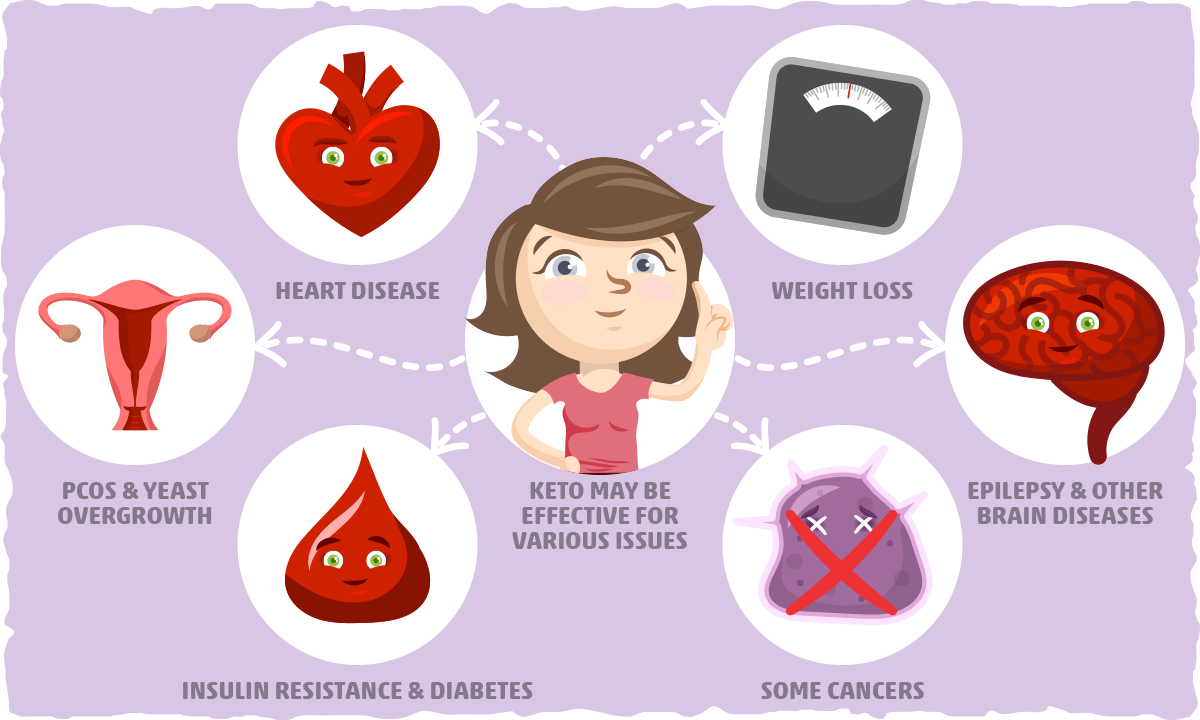
According to the research literature and the abundance of success stories, the keto diet can be a safe and effective weight loss approach that helps improve many common women’s health struggles.
The keto diet may be most effective for women who are struggling with:
- Weight loss and yo-yo dieting
- Epilepsy
- Polycystic ovarian syndrome (PCOS)
- Yeast overgrowth
- Insulin resistance, type 1 diabetes, or type 2 diabetes
- Heart disease
- Neurodegenerative diseases such as Alzheimer’s or Parkinson’s
- Certain forms of cancer
That being said, some groups of women may find a different low-carb approach to be better for their overall health. This may include women who are:
- Female athletes/lifters that notice a significant drop in performance and recovery on keto 2-3 months.
- Struggling with a hypothyroid condition that isn’t responding well to keto.
- Notice a worsening in blood lipid levels when they eat high amounts of saturated fat.
- Gain fat on a keto diet after tracking macros
- Have stopped menstruating or are having an irregular cycle
- Are pregnant or breastfeeding before their body has adapted to keto
- Notice an increase in menopause-related symptoms after 2-3 months of keto
Regardless of your current health condition, we must also keep in mind that the success of any diet depends significantly on the person. It will take some self-experimentation before you find out what approach to keto is the right fit for you.
Although this implies there will be some ups and downs along the way, this also means that you are not destined to be less healthy and gain fat as you age. Even if you are over 50 and struggling with menopause, you will still be able to achieve your health and weight loss goals.
What Results are Possible for Women? Before and After Keto Success Stories
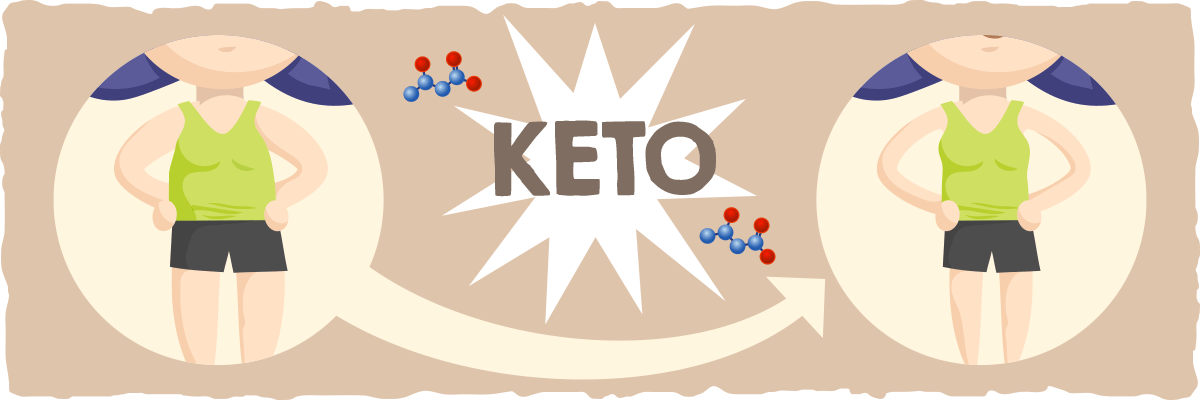
The beauty of the keto way of eating is that women of all ages can experience tremendous results. From boosting fertility during the childbearing years to losing fat and improving health after 50, you’ll find a keto success story from virtually any background.
For example, check out Elena’s before and after. Not only was she able to drop over 80 pounds, but her 9-year old daughter experienced a positive change in her health as well.
Many postmenopausal women have witnessed wonderful transformations as well. One of the most inspiring success stories I’ve read is from Kathleen.
After struggling with weight loss, high cholesterol, and autoimmune issues for decades, she decided to give keto a try. Now, at the age of 65, she is down 40 pounds and continues to use her keto lifestyle to manage her heart health and autoimmune-related symptoms.
These are just two examples of the thousands of keto success stories for women. After giving it a try, you may find the keto way of eating to be the missing piece as well.
Now that you know what’s possible with keto and why it works, let’s take a closer look at how it affects each phase of a woman’s life.
Important Keto Considerations Throughout a Woman’s Life: From Menstruation to Menopause and Everything in Between
Diet plans, weight loss pills, and other “fat burning” supplements rarely consider issues most relevant to a woman’s health, even when they are marketed exclusively toward women. The promise of immediate results often becomes the primary focus, while more important issues, such as fertility, the menstrual cycle, mental health, and menopause, are left unaddressed.
To formulate a diet that helps you improve your health and body composition in a sustainable way, we must take the following factors into consideration:
Key Evolutionary Differences Between Men and Women
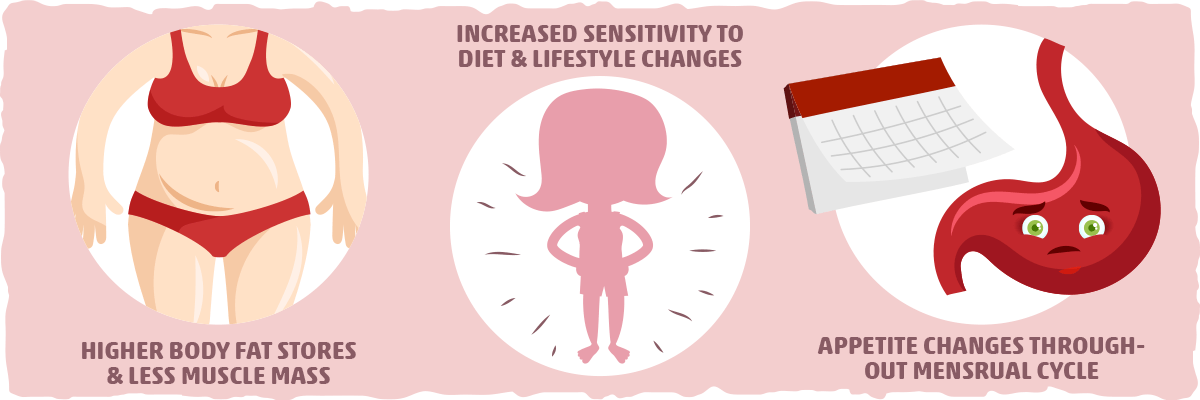
Women are gifted with the power to foster, grow, and birth new life into this world. To protect our ability to have children, women have evolved several adaptations to resist rapid fat loss and infertility. These adaptations include:
- Increased body fat %. Women tend to have at least 10% more body fat stores and less muscle mass than males. This helps maximize the essential fatty acids and energy available to support fetal development without excess muscle mass stealing energy away from the baby. Though this is crucial for fertility, having less muscle can make weight loss more difficult. One way to counteract this (while improving overall health) is with resistance training and adequate protein intake (two powerful tips we will learn about later). Not only will this strategy help you gain muscle, but it will make it easier to control your appetite and lose fat.
- Increased sensitivity to diet and lifestyle changes. Rapid decreases in calorie and/or carb consumption can cause rapid fluctuations in sex hormones, stress hormones, and thyroid function that impair fertility, mood, and fat loss. If you find keto diet to be too stressful for your body, then you may want to decrease carb consumption little by little until you find a carb limit that works for you. The same logic applies to calorie consumption as well. Rather than focusing on rapid fat loss, find a food intake level that helps you maintain your health, vitality, and fertility while you lose weight at a steady pace (1 to 2 pounds per week).
- Ravenous cravings and appetite changes throughout your menstrual cycle. Research data has found that women tend to eat more during the luteal phase of the menstrual cycle, compared to the follicular phase that leads up to ovulation. Typically, we reach for a calorie-dense combination of fat and sweet, which is why candy bars and ice cream tend to find their way into your stomach around the beginning of your cycle. The best way to counteract these powerful cravings is to make sure you have healthy, keto-friendly alternatives at the ready. Allow yourself some room to enjoy keto desserts and snacks during this phase, knowing that you’ll find it easier to eat less and lose more fat as you progress through ovulation. (Just make sure you keep any high-carb, unhealthy snacks, desserts, and candy bars out of sight.)
The Connection Between Keto, Weight Loss, and Your Menstrual Cycle
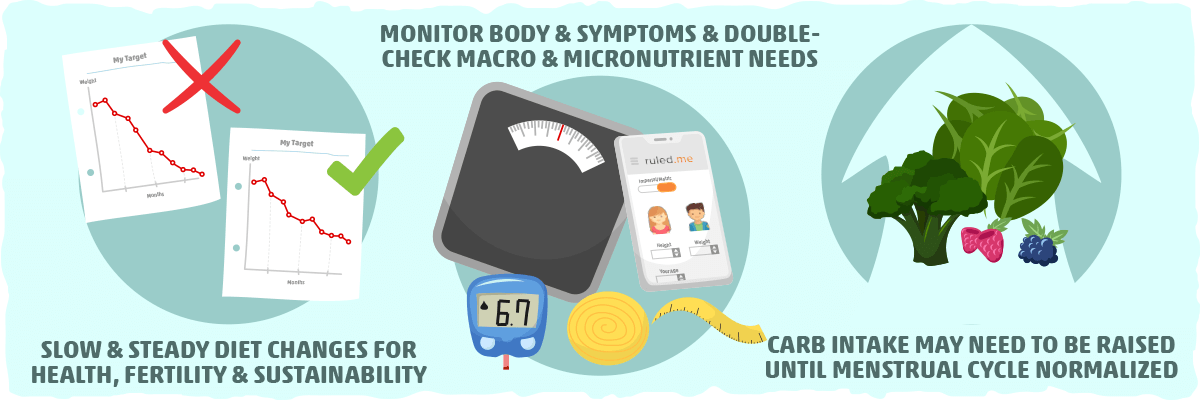
Women have a significant advantage over men when it comes to dieting: the menstrual cycle. If it becomes erratic or non-existent after making a specific dietary change, this is a clear sign that your current approach is too stressful for your body.
In response to any form of consistent stress, the hormones that start and maintain your menstrual cycle will decrease significantly. This will happen if you are consistently eating too few calories, restricting carbs too low, getting too much exercise, getting too little sleep, or experiencing excess emotional stress.
One way to ensure optimal health, fertility, and sustainability with your diet is by going slow and steady with each adjustment you make. Slow and steady changes may not lead to rapid results, but they will help you achieve long-lasting transformations.
If, after following a slow and steady keto approach for 2-3 months, you find it to cause menstrual cycle irregularities and negative symptoms, then your body is telling you to monitor your diet more closely. Double-check to make sure you are meeting your macronutrient and micronutrient needs.
In some cases, it may be necessary to increase carbohydrate intake until the menstrual cycle is normalized. Experts suggest that women who struggle with keto should consume around 75 to 150 grams of carbohydrates per day.
That being said, If you have PCOS or other issues that cause menstrual cycle irregularities or infertility, a keto diet may be the approach you need to improve your health and boost reproductive success. To learn more, scroll down to “The Keto Diet for Other Women’s Health Issues” section.
Keto Dieting During Pregnancy and Breastfeeding
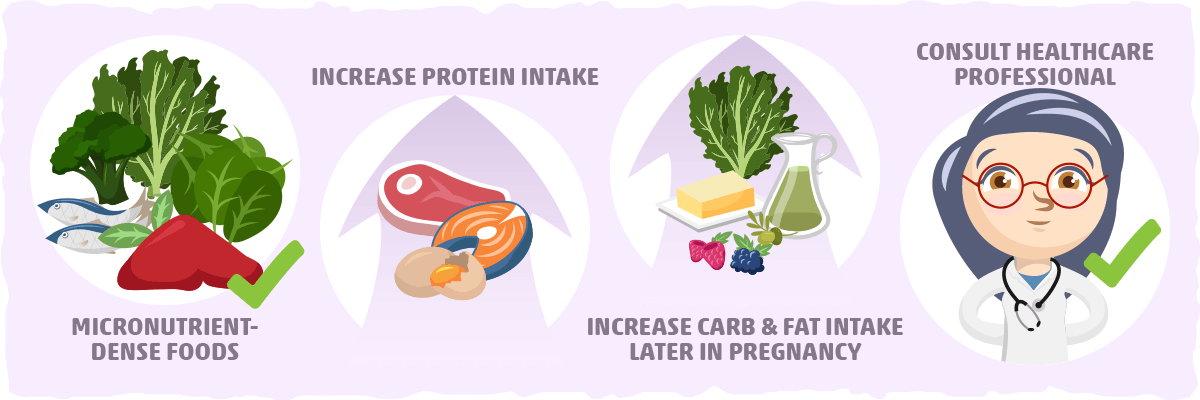
Throughout your pregnancy and while nursing, it is best to focus on nourishing your body with plenty of macronutrients, vitamins, and minerals. Never aim to lose weight or implement weight-loss strategies (like intermittent fasting) while pregnant or breastfeeding.
If you are pregnant or breastfeeding and want to stay on a keto or low carb diet, here are some recommendations that will help:
- Eat micronutrient-dense foods every day. The most nutrient-rich foods are pasture-raised organ meat, wild-caught sardines, and low-carbohydrate vegetables like spinach, kale, and broccoli. During early pregnancy and before conception, foods higher in folate, such as liver and dark leafy greens, are essential. Vitamin D, iodine, and DHA are crucial as well.
- Increase your protein intake. You should aim to eat between 1 and 1.2 grams per pound of lean mass throughout pregnancy and breastfeeding. Use our keto calculator to find the right amount of protein for you.
- Up your carb and fat intake later in pregnancy. during the last trimester and while your breastfeeding, consume an extra 30-50g of carbs from fruit and dark green vegetables per day to aid milk production. Adding extra calories from fat (300-500 calories worth) is recommended as well.
- Consult your healthcare practitioner before making changes. Always make sure you are working together with your doctor to ensure the best health for you and your child.
Please note: These recommendations are only for women who have followed keto for several months and have found it to be a healthy and effective approach for them prior to conception. Don’t start keto while you are pregnant or breastfeeding.
Family Life and the Keto Diet
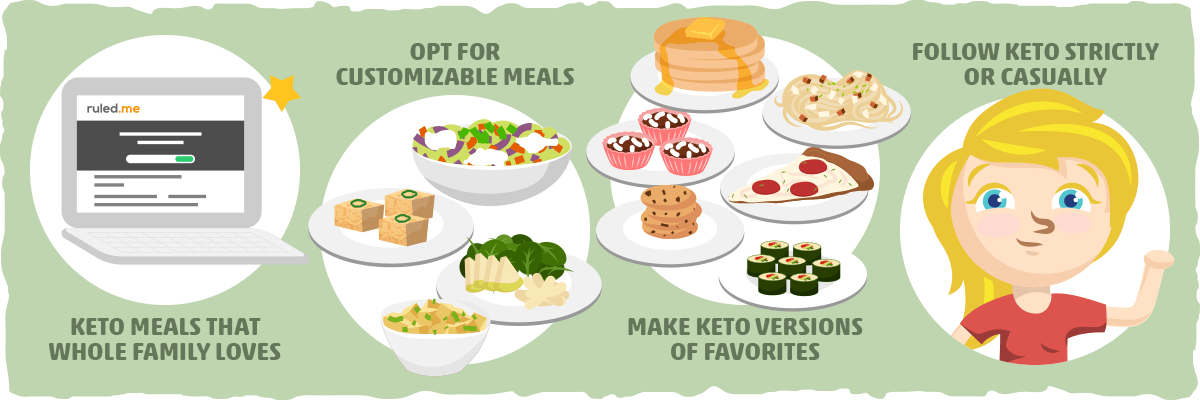
Though keto can be a healthy diet for the whole family, it may be challenging to stay keto-friendly with all the carb-laden temptations around us. Plus, the vast difference in food preferences between you and your children can make it even more difficult to stay strict.
Fortunately, there are many ways to achieve your health and weight loss goals without forcing everyone to eat keto all the time. Let’s take a look at some of the easiest options:
- Make keto-friendly meals that the whole family loves. We offer hundreds of keto recipes that have become family favorites throughout the keto community. The beauty of keto-friendly cooking is that you can mimic almost any flavor and texture that we often crave in an unhealthy, carb-laden package. For some inspiration, check out our keto recipe catalog.
- Opt for easily-customizable meals. You may find that the whole family will enjoy a keto-friendly meat dish, but won’t touch the low-carb vegetables. This is when you can mix and match sides, serving carb-rich favorites to your family while making delicious keto options for yourself. Your sides might also inspire them to try more keto-friendly recipes.
- Make a keto-approved version of classic favorites. Pizza, pasta, muffins, cookies, sushi, pancakes, ice cream, and even chicken nuggets can be made in a keto-friendly way. These recipes are so flavorful that your family may start requesting the keto version instead.
- Follow strict keto whenever you can. When all else fails, you can always fall back on a more relaxed approach to keto. Rather than forcing 100% strict keto eating into your lifestyle, try making changes to your diet that you have the most control over first. For example, you can try intermittent fasting through breakfast, eating keto-friendly options at work, or using keto snacks as a way to keep you from overeating at dinner or during family parties. You may not be able to get all the benefits of keto by following this relaxed style, but it can still help you improve health, lose weight, and sustain your results.
What About Menopause? The Keto Diet for Women in their 40s, 50s, and Beyond
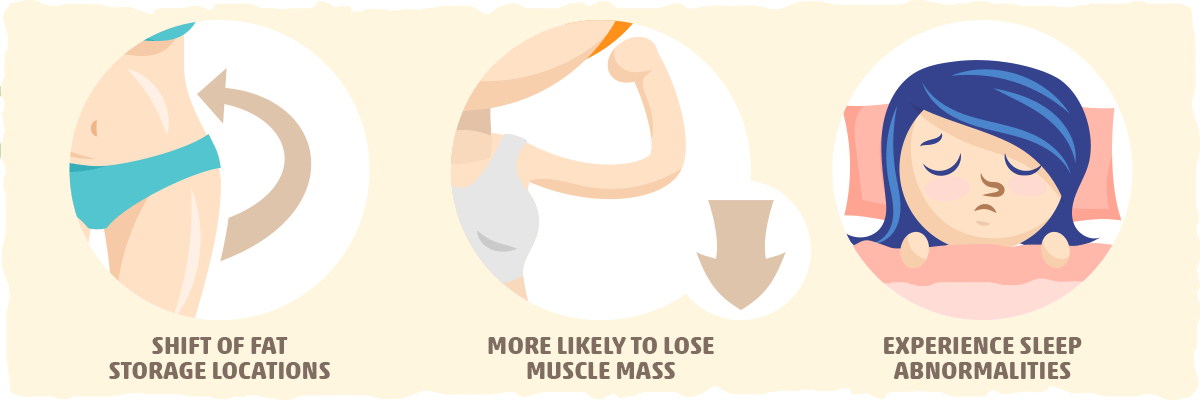
Hormones play a significant role in determining how much fat you store and where that fat is stored. As you transition through perimenopause into menopause, you may experience a shift in your health, mood, and how your body looks.
This happens because the female sex hormones that are declining during this time influence how we feel and where we store fat.
As these hormones decrease, body fat is more likely to be stored around the belly rather than the hips, thighs, butt, and breast tissue like before. If you notice an increase in belly fat during menopause, this is one of the reasons why.
Along with this shift in body composition, we are more likely to lose muscle mass and experience sleep abnormalities as well. This is one of the major factors that makes it more challenging to improve health and lose weight as we age.
There is, however, a silver lining to all of these changes. Though menopause may make it more challenging to achieve your goals, it can’t keep you from losing fat and improving your overall health.
In fact, the same weight loss principles that have helped women in their 20’s and 30’s transform their bodies apply directly to women going through menopause as well. The only difference between the two is that, as you get older and your female sex hormones decrease, it is even more crucial that you stay consistent with the diet and lifestyle changes that work best for you.
Keto Diet Plan and Macros for Women: How to Get Started
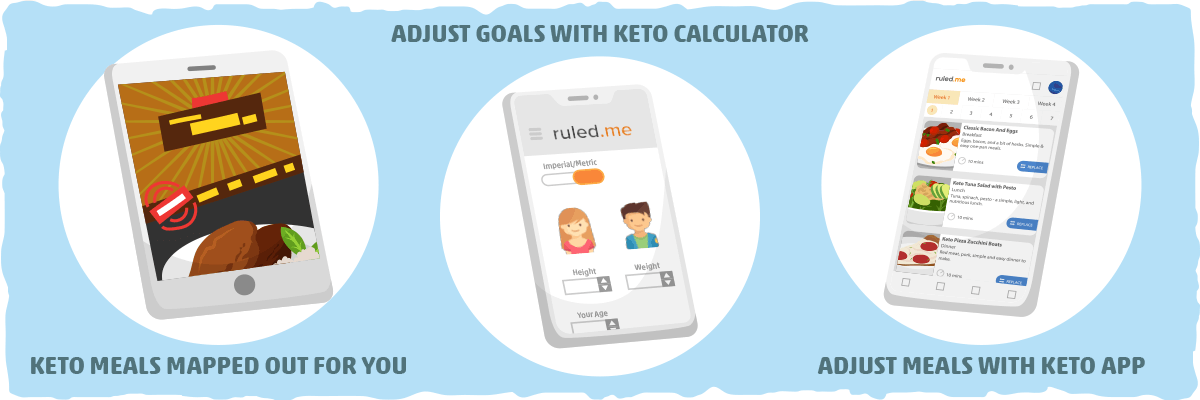
One of the simplest ways to see if keto works for you is by following a short-term diet plan. Not only will this approach help you lose weight, but it will serve as a brief trial with keto eating to find out if it is a good fit for your health, lifestyle, and food preferences.
If you are looking to get started, we offer several keto diet plans that women of all ages have used to get the results they want:
- Our 30-day meal plan — One month of keto meals mapped out for you.
- Our Keto Diet App — An easy-to-use app that makes you an entirely personalized meal plan based on your goals and preferences. All you’ll need to do is cook the recipes and eat them.
As you follow a keto diet plan, make sure you customize the servings to fit your personal macro intake goals. The easiest way to do this is to plug your information into our keto calculator and adjust the recipes accordingly. (If you are using our keto diet app, this will be done for you.)
It is also important to think about what you will do after your trial with keto eating comes to an end. What changes will you need to make to achieve and maintain your results?
To help you turn your short-term diet plan into a lifelong keto lifestyle, we’ve included ten success tips and several resources in the next section.
10 Keto Success Tips for Women of All Ages
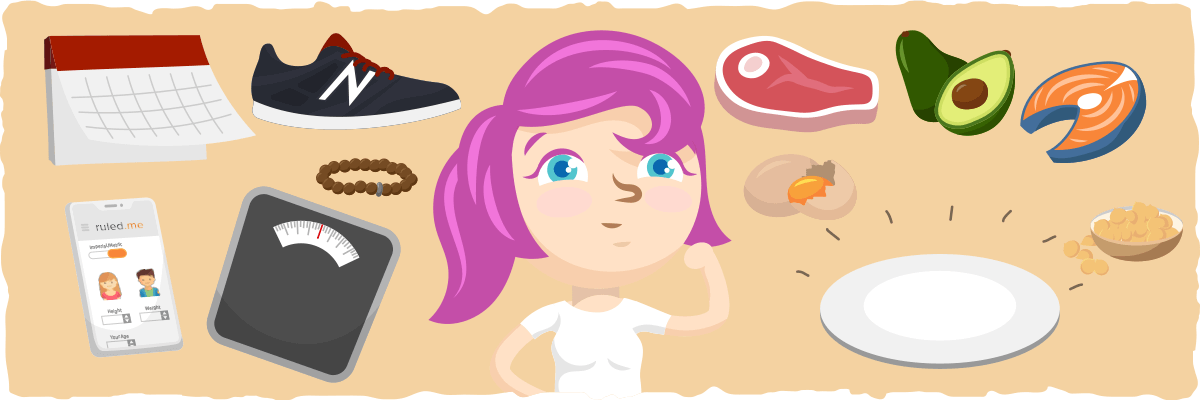
If you’d like to transition from a strict meal plan to a keto lifestyle that will make your results easier to maintain, try implementing the following tips:
1. Set Realistic Goals and Prioritize Lifelong Success.
When it comes to following a weight loss plan, we often expect the numbers on the scale to decrease every morning until we reach our goal. Then, we will be able to eat what we want while our weight stays the same.
It may sound ridiculous to you, but this is often how weight loss plans and pills are sold to us, creating a false representation of what to expect. In reality, the path to getting the results you want will have its ups and downs as you figure out what strategies work best for you, your health, and your lifestyle.
This is why we recommend considering your short-term goals in the context of a long-term lifestyle that will help you maintain your results. Rather than looking for the perfect diet plan, focus on changing your lifestyle in a way that makes healthy eating convenient and easy.
To make sure you are trending in the right direction, we recommend monitoring your weight, body composition, and overall health only once a month in the beginning. Checking every day or even just once a week can be misleading as your weight naturally fluctuates with changing hormone levels.
In general, a healthy weight loss goal to strive for is 4 to 8 pounds per month. If your weight loss stalls for two consecutive months, try implementing some of the other tips below.
2. Start Simple and Build Your Keto Lifestyle from There.
Sometimes all it takes is one simple rule to get you the results you want. For many women, this rule is “eat keto foods” — that’s it.
To give this a try, eat as much as you want from our keto food list and avoid high-carb foods like grains, starches, sugary beverages, and sugar-filled processed foods. Keeping your lifestyle this simple may be all you need to get the results you want.
3. Engineer Your Food Environment to Feed Your Results.
In other words, make keto food as convenient to consume as possible and turn unhealthy choices into a painfully inconvenient experience. By doing so, you can increase the likelihood that you will make the right choice in the future, even when you are stressed, tired, and hungry.
For an in-depth look at how to transform your food environment, check out our guide to maintaining your keto weight loss results for life.
4. Track What You Eat for 1-2 Months.
Though eating less is often regarded as the key to weight loss, eating too little can impair long-term results and overall health, particularly for women. In contrast, overeating will cause us to gain body fat, regardless of how much you restrict carbs.
This is why it is crucial to develop a greater awareness of what goes on your plate and what your body needs for optimal results.
To learn more about how to track your keto meals, we put together a comprehensive guide to macro tracking that you can find by following this link.
5. Make Sure You’re Getting Enough Protein.
Eating the right amount of protein each day is crucial to your success on any diet, especially keto. When protein consumption is too low, we tend to experience intense cravings, decreased energy levels, and less satisfaction from our meals.
On top of that, protein helps us maintain and build muscle mass, which not only makes us look better but helps accelerate fat loss results as well.
If you tend to struggle against a ravenous appetite when you diet, then low protein intake may be the culprit. Follow these protein guidelines to reap the benefits of this essential macronutrient:
- If you are sedentary — consume 0.6 – 0.8g of protein per pound of lean body mass.
- If you are regularly active — have 0.8 – 1.0g of protein per pound of lean body mass.
- If you lift weights — eat 1.0 – 1.2g of protein per pound of lean body mass.
Or, if you’d like the math to be done for you, use our keto calculator instead.
6. Try Intermittent Fasting.
Intermittent fasting goes against two common food myths that are often marketed toward women: (1) breakfast is the most important meal of the day, and (2) if you skip a meal, your metabolism will crash, and you’ll gain fat.
Fortunately, the extensive literature on intermittent fasting has found both assertions to be false. In fact, many women on keto have found skipping breakfast or fasting for 14-16 hours each day to be a key component of their long-term weight loss success.
To learn more about this popular fat loss tip and how to add it to your keto lifestyle, check out our keto guide to IF.
As with any other diet change, make sure you monitor your health when you start implementing this strategy. If it causes menstrual cycle irregularities or triggers any other negative symptoms, you may need to eat more food with each meal or increase your meal frequency.
7. Cut Out the Alcohol.
Unfortunately, alcohol is a poison that forces the body to put hormonal regulation on hold while your liver focuses on detoxifying the toxin.
As a result, women who drink alcohol regularly tend to have higher estrogen levels than non-drinkers, which can worsen symptoms related to premenstrual syndrome (PMS) and menopause.
Even if you aren’t struggling with PMS or menopause, the calories from alcohol and the sugar found in many alcoholic drinks can still impair your health and weight loss results.
In fact, cutting out alcohol (or keeping your intake to a minimum) may be all you need to break through your weight-loss plateau and keep PMS or menopause under control.
8. Increase Your Activity Levels and Start Resistance Training.
Exercise may not directly cause weight loss, but it is one of the secret ingredients behind preventing weight regain. Several studies have found that those who are most likely to lose weight and keep it off are the ones who exercise regularly.
If you want to get the most bang for your buck, I recommend doing some form of resistance training 2-3x a week. Not only will this increase your activity level each week, but it will help you build precious muscle, improve overall health, and make fat loss easier.
9. Prioritize Sleep and Stress Relief Practices.
Poor sleep can single-handedly derail any diet plan by robbing us of our precious willpower and increasing our cravings for unhealthy foods. Chronic emotional stress can trigger the same struggles, along with making it harder to get quality sleep and fend off symptoms related to PMS or menopause.
If you’ve struggled a lot with weight loss and female health issues in the past, poor sleep and chronic stress may be at the root of it. Here are some guidelines you can follow to improve your sleep quality and stress resilience:
- Sleep in a quiet, dark, and cool room (between 60 and 67 degrees Fahrenheit).
- Wear ear plugs and an eye mask if you can’t keep your bedroom dark and quiet.
- Limit screen time and blue light from your tv, phone, and other electronic devices after the sun sets.
- Go to bed and get up at the same time each day.
- Stop consuming caffeine by noon.
- Avoid using marijuana, alcohol, or over-the-counter drugs to help you sleep.
- Get sunlight exposure in the morning each day.
- Do some form of exercise daily.
- Try taking a yoga, tai chi, or qi gong class.
- Use meditation and mindfulness techniques before bed to help you transition to sleep.
- Eat each meal slowly, tasting and chewing each bite thoroughly.
- Make sure you are eating the right amount of macros each day.
10. Do Keto with Friends, Family, And Other Keto Women.
Making changes is much more challenging when we don’t have any social support. To help you on your keto journey, let your friends and family know about the shift you are making and see if anyone wants to join you.
Or, if your loved ones aren’t on the keto train yet, try reaching out to our online keto community. There you’ll find thousands of women that can help you with each step of the way.
The Bigger Picture: How to Find Out If Keto is Right for You
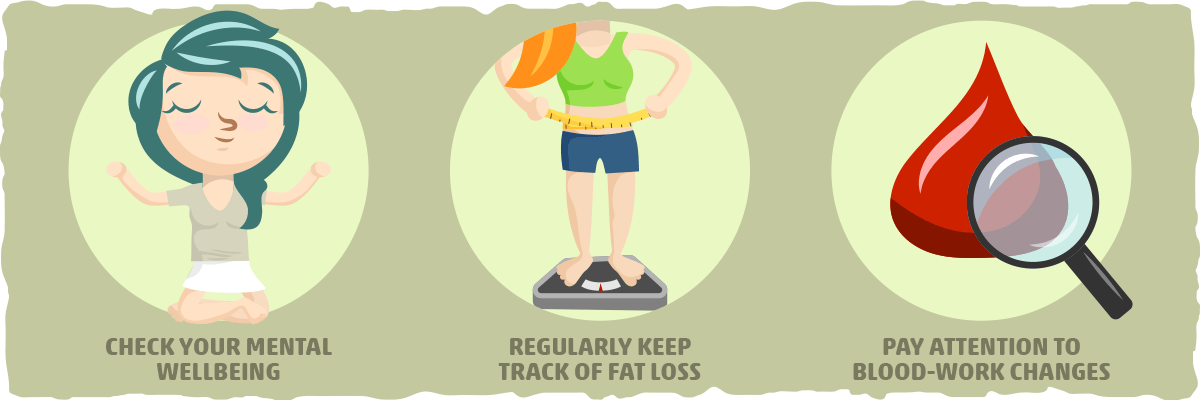
The secret to improving your health and achieving weight loss results that last a lifetime is not a perfect diet plan or keto fat loss supplement. The truth is that the best diet will be one that is the right fit for you, your health, and your lifestyle.
The optimal approach will be one that you create for yourself as you learn what works for you and what doesn’t. To help you accelerate this process, make sure you are monitoring these three aspects of your health as you make changes:
- Your mental wellbeing. After a month of following keto, reassess how you are feeling. Are you feeling better than you did with your previous lifestyle? Or, are you feeling down and drained most of the time? If you are really struggling with keto after 1-2 months, then consider adjusting your way of eating so that it enhances your sense of wellbeing.
- Body composition. One of the simplest ways to keep track of your fat loss is by using the scale and measuring your waist circumference. Monitoring these numbers once a month will provide you with a much more accurate representation of how well your diet is working for you. In other words, if you aren’t losing weight or inches after a week, don’t panic. Stick with your diet plan for at least one month before you check your progress and adjust your diet (if you need to) from there.
- Blood biomarkers. Pay close attention to how your blood-work changes after you’ve followed keto for 1-2 months. Make sure your blood sugar, cholesterol, A1C, triglycerides, and other biomarkers relevant to your condition are trending in the right direction.
As you monitor your results and adjust your diet from there, you will be able to reach your goals in a way that is healthy and sustainable for you.
That being said, there are a few other topics we have yet to explore in-depth. Before we close out our keto guide for women, let’s take a closer look at several important issues that millions of women are struggling with.
The Keto Diet for Other Women’s Health Issues: Severe PMS, PCOS, Hot Flashes, etc.
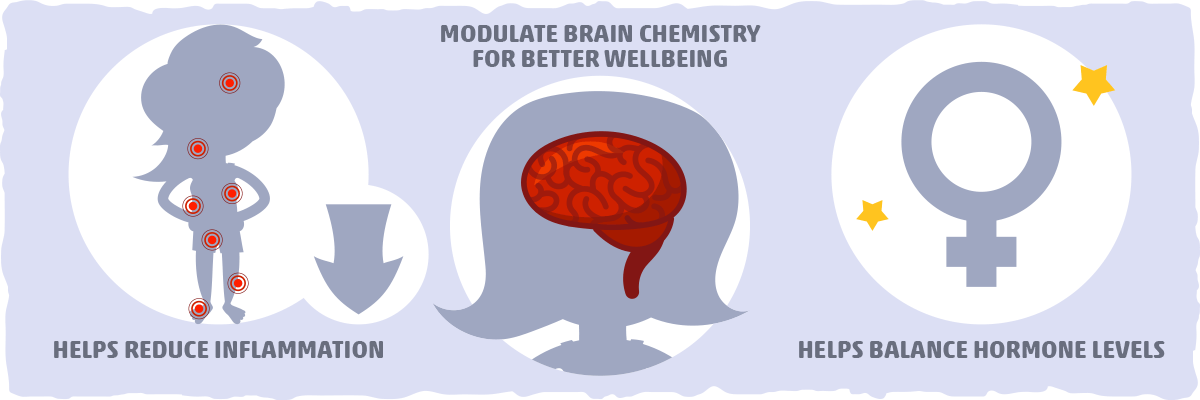
Although the information above covers the most important aspects of women’s health, there are several other conditions that deserve their own section as well:
- Keto for PCOS and infertility
- Keto for PMS, PME, and PMDD
- Keto and UTIs
- Keto for Hot Flashes
Keto for PCOS and Infertility
Polycystic ovary syndrome (PCOS) is responsible for as much as 70 percent of infertility issues in women. On top of that, it can cause acne, male-pattern baldness, mood swings, weight gain, and fatigue.
Fortunately, many women can stop their PCOS with the right combination of diet and lifestyle changes. The ketogenic diet, for example, may be one of the best diets for PCOS because it reduces insulin levels and insulin resistance (one of the main causes of PCOS).
For more information on how to use the keto lifestyle for PCOS, follow this link.
Keto for PMS, PME, & PMDD
Premenstrual syndrome (PMS) is the combination of symptoms that some women suffer from a week or so before their period. Many women also experience severe psychological symptoms before their period, which will either be diagnosed as PMDD (premenstrual dysphoric disorder) or PME (premenstrual exacerbation).
PMDD is a direct result of hormonal fluctuations and hormone receptor shifts, which manifest as extreme psychological distress and dysphoria during the last week of the luteal phase.
PME refers to the premenstrual worsening of the symptoms of another mental health disorder, such as major depressive disorder or generalized anxiety disorder.
Whether you are suffering from symptoms characteristic of PMS, PME, or PMDD, the cause of each one appears to be highly individual, and no diet has been found to help consistently. That being said, there is still hope!
Current data suggests that poor diet and lifestyle habits are associated with PMS and its psychological symptoms. Smoking and the consumption of processed foods, in particular, were found to be the strongest risk factors.
This indicates that making healthy changes to your lifestyle and eating habits may help reduce the severity of your PMS, PME, or PMDD.
Regarding the keto diet specifically, the current research suggests that this approach:
- Can decrease inflammation. Inflammation has been associated with many premenstrual symptoms. The ketones, calorie restriction, and fat loss have all been found to reduce inflammation levels. The keto diet can help us reap the benefits of all three.
- May help balance hormone levels. Unhealthy foods and chronic stress can trigger massive fluctuations in hormones throughout your cycle, which may cause and/or exacerbate the symptoms you experience. By following the keto diet, you might be able to prevent these hormonal fluctuations and minimize the resulting symptoms.
- May modulate neurochemistry for better wellbeing. Emerging research findings indicate that ketones can shift brain chemistry in a way that can decrease feelings of anxiety and depression. This might be helpful for women with PME and PMDD.
Although these findings are promising, they are only speculative. If you are suffering from one of these issues, it is best to consult with a health care practitioner that understands your condition and can help you make the appropriate lifestyle changes.
Keto and Urinary Tract Infections (UTIs )
The only study regarding the impact of keto on UTIs was a collection of case reports from 1933, suggesting that keto may be helpful. The mechanism proposed in the study is that ketone excretion increased the acidity of the urine. This acidity may make it more difficult for bacteria to infect the urinary tract.
That being said, if you are struggling with chronic UTIs, it is best to prioritize hygiene and proven treatments before looking to keto for help.
Keto for Hot Flashes
Hot flashes and night sweats can occur during your transition through menopause, as fluctuating hormone levels cause changes in body temperature regulation.
Current evidence suggests that weight loss and healthy food choices can reduce the likelihood of experiencing hot flashes and other common menopause symptoms. This means that keto can help ease your transition through menopause as long as it enables you to lose fat and improve your overall health.
However, it is also possible for the keto diet to cause a temporary increase in hot flashes and other menopause-like symptoms as your body adjusts to a lower carb intake and ketosis. This tends to go away within the first week of keto, but you can remedy many of the symptoms by following the tips in our guide to the keto flu.
Mythbusting: False Claims about Keto, Women’s Health, and Weight Loss
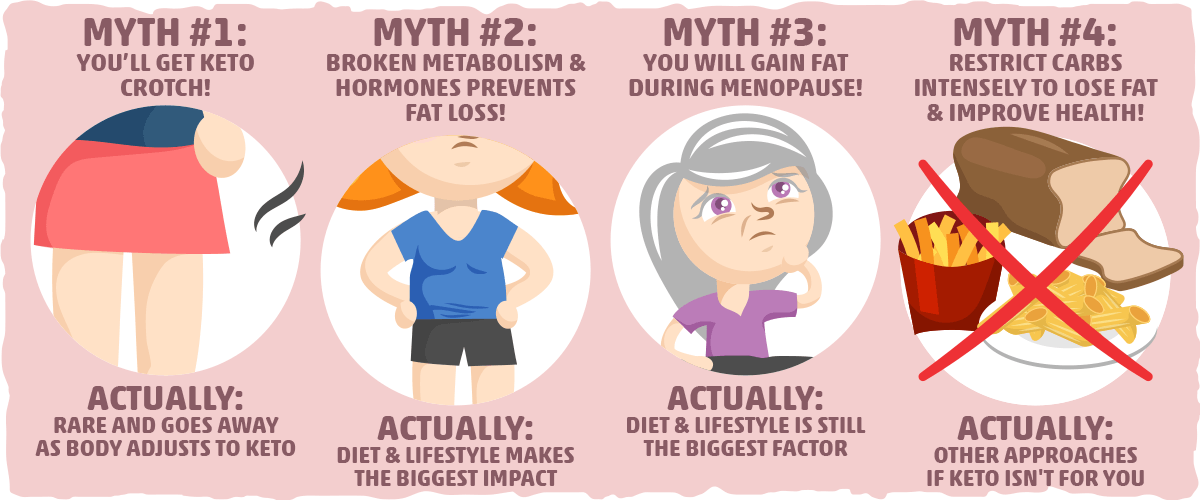
Popular media and advertisements are often riddled with false claims that may discourage you from making the right changes for your health. To help you separate fact from fiction, let’s address some of the most common myths regarding keto for women:
Myth #1: “You’ll get keto crotch!”
“Keto crotch” refers to a temporary change in vaginal odor in women who are adapting to the ketogenic diet. This change in odor, however, is relatively rare — and even the worst-case tends to go away as the body adjusts to keto.
Myth #2: “Can’t lose fat? Your metabolism and hormones are broken!”
Fortunately, your diet and lifestyle are what will make the biggest impact on body fat levels and overall health. Studies continuously show that the combination of a healthy diet and exercise is the most effective weight loss approach for women and men of any age.
The main culprit behind subpar results is an unsustainable approach, not a broken metabolism or faulty hormone balance. We tend to rely on restriction and willpower to lose weight, only to gain most of it back when we lose the motivation to force another salad down.
This repetitive cycle of weight loss and fat gain is the inevitable result of using a short-term approach to transform the body you’ll have for the rest of your life.
To make a lasting change, you must focus on creating a dietary approach that is both healthy for you and sustainable for long-term dieting. For practical examples and tips on how to do this, read through our comprehensive guide to maintaining keto results for life.
Myth #3: “You will gain fat during menopause.”
Although there are several changes during menopause that can increase your likelihood of gaining body fat, this doesn’t mean you are destined to grow a gut.
Regardless of what stage of menopause you are going through, the diet and lifestyle tips we’ve discussed throughout this guide can help you burn fat and improve health. In fact, many women have reported feeling and looking better than ever before after switching to a keto-friendly lifestyle.
Myth #4: “You must restrict carbs as low as possible to lose fat and improve health.”
Despite how keto-centric this guide has been, it is important to remember that cutting carbs is not the only way to achieve your goals. There are plenty of dietary approaches you can try if your keto experiment doesn’t go as expected.
For example, a non-ketogenic, low carb diet (with over 100 grams of carbs per day) may be a better option for women who:
- Do high-intensity training several times per week and notice a drop in performance and recovery on keto
- Have an underactive thyroid that isn’t responding well to keto
- Have familial hypercholesterolemia
- Struggle to lose weight or start gaining weight after 1-2 months of the keto diet
- Have stopped menstruating or are having an irregular cycle
- Are pregnant or breastfeeding
- Notice an increase in menopause-related symptoms after 1-2 months of keto
This is why it is crucial to monitor your health and wellbeing as well as your body composition while you follow keto. Sometimes upping your carb intake or using a cyclical keto approach can be a healthier option than decreasing your net carb limit.
Key Takeaways — Keto Principles For Women
The current research literature (and hundreds of success stories) indicate that the ketogenic diet can be helpful for women who are struggling with:
- Repetitive cycles of weight loss and regain
- Fat loss plateaus
- Fat gain during menopause
- Epilepsy
- Polycystic ovarian syndrome (PCOS)
- Yeast overgrowth
- Heart disease
- Insulin resistance, type 1 diabetes, or type 2 diabetes
- Neurodegenerative diseases such as Alzheimer’s or Parkinson’s
- Certain forms of cancer
- The symptoms of PMS, PME, PMDD, or menopause
Regardless of your health goals or the condition you may be struggling with, always make sure to monitor your overall health and stick with the changes that work best for you. This will take some trial and error, but after several months, you’ll be able to create a keto lifestyle that is the right fit for you.
To help you on your keto journey, here is a quick recap of the tips and strategies we mentioned throughout the guide:
- Set realistic goals and prioritize lifelong success.
- Engineer your food environment in a way that feeds your results.
- Track what you eat to develop a better awareness of your meals and macros.
- Try intermittent fasting.
- Make sure you eat enough protein and fat each day. (Use our keto calculator to help you find out how much you should aim to eat.)
- Cut alcohol out of your diet.
- Increase your daily activity levels.
- Do resistance training 2-3x per week to make fat loss easier to achieve and sustain.
- Prioritize sleep and add stress relief practices to your day.
- Join our online keto community and make lifestyle changes with a friend or family member.
If you’re not sure where to begin, try starting with a comprehensive keto meal plan. This will give you a chance to experiment with the keto diet for a couple of months and find out if it is an effective approach for you.
To help you get started, we’ve included links to our most popular diet plans for women below:
- Our 30-day Meal Plan — one month of keto meals mapped out for you
- Our Keto Diet App — An app that makes you a fully personalized meal plan based on your goals and preferences. All you need to do is cook the recipes and eat them.
Sources
- Gender Differences in the Appetite Response to a Satiating Diet — Journal of Obesity
- The Benefits of The Ketogenic Diet — Ruled.me
- Effects of dietary composition on energy expenditure during weight-loss maintenance. — NCBI
- Keto & Weight Loss — Ruled.me
- The role of stress and the hypothalamic-pituitary-adrenal axis in the pathogenesis of the metabolic syndrome: neuro-endocrine and target tissue-related causes. — NCBI
- How to Lose Weight on a Ketogenic Diet — Ruled.me
- Functional hypothalamic amenorrhea and its influence on women’s health — NCBI
- The ketogenic diet: adolescents can do it, too. — NCBI
- Learn How To Avoid The Keto Flu [Symptoms & Remedies] — Ruled.me
- Regulation of body composition and bioenergetics by estrogens — NCBI
- The Role of Estrogens in Control of Energy Balance and Glucose Homeostasis — NCBI
- Premenstrual Syndrome — American Family Physician
- Therapeutic Potential of Exogenous Ketone Supplement Induced Ketosis in the Treatment of Psychiatric Disorders: Review of Current Literature — frontiers in Psychiatry
- The ketone metabolite β-hydroxybutyrate blocks NLRP3 inflammasome-mediated inflammatory disease. — NCBI
- The Association of Inflammation with Premenstrual Symptoms — NCBI
- MENOPAUSAL HOT FLASHES: MECHANISMS, ENDOCRINOLOGY, TREATMENT — NCBI
- Premenstrual Syndrome Is Associated with Dietary and Lifestyle Behaviors among University Students — NCBI
- THE KETOGENIC DIET IN THE TREATMENT OF INFECTIONS OF THE URINARY TRACT — NCBI
- Effects of a dietary intervention and weight change on vasomotor symptoms in the Women’s Health Initiative — NCBI
- Dietary Protein and Exercise Have Additive Effects on Body Composition during Weight Loss in Adult Women — The Journal of Nutrition
- Circulating sex hormones and breast cancer risk factors in postmenopausal women: reanalysis of 13 studies. — British Journal of Cancer
- Exercise is more critical than diet to maintain weight loss — ScienceDaily
- Consequences of physical inactivity in older adults: A systematic review of reviews and meta‐analyses — Wiley Online Library
The post Keto Guide for Women: Lose Weight and Improve Health at Any Age appeared first on Ruled Me.
via Keto Diet




COMMENTS